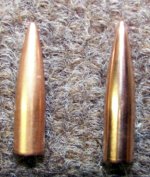boron nitride, tungsten disulfide, or molybdenum disulfide?
Jimm, I’m glad that you asked about boron nitride and tungsten disulfide. I think that maybe we’re getting somewhere now! In this message, for brevity sake, I’ll just type COF instead of coefficient of friction. Let’s consider 2 variables – COF and “slipperiness”. This is, of course, between 2 surfaces of different materials (the steel of the bore, and the jacket of the bullet). After studying COF a bit, I think that I’m correct in thinking that there is an INVERSE relationship between COF and slipperiness, i.e., a LOWER COF denotes a MORE slippery substance. A DIRECT relationship would mean a lower COF denotes a LESS slippery substance. Hopefully, an engineer, or someone with the proper technical knowledge, will tell me if I’m correct about a lower COF denoting a more slippery substance.
So, if I’m correct about the inverse relationship, we would want the substance with the lowest COF, which would be the slipperiest. If we didn’t care about other real-world things such as cost, availability, “dirtiness”, hygroscopic property (absorbs moisture from the air), etc., then we would just want to get the substance with the lowest COF.
If boron nitride is the slipperiest substance, we must choose the proper type. I’m guessing that the proper type is the hexagonal boron nitride (hBN). And, I assume that the smaller the particle, the better. If that’s true, we would want the Nano hBN (particle size .070 micron). It appears that as the particle size decreases, cost increases (another example of an inverse relationship, this time between the 2 variables particle size, and cost).
Now, it’s possible that the effectiveness of the substance does not increase once you go smaller than a certain particle size. In other words, perhaps the nano stuff is no more effective than the .5 micron stuff, for example. I don’t know. I would want to use the substance that is the most effective, at the least cost, but I don’t know which is the best particle size for effective bullet coating.
So, several questions remain: (1) which is the best substance (boron nitride, tungsten disulfide, molybdenum disulfide)? (2) which is the best boron nitride (hexagonal or other, Nano, 150 nm, .5 micron, 1.5 micron, 5 microns…)? (3) Is the relationship between COF and slipperiness an inverse one?
Jim B.


